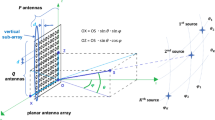Abstract
For passive source localization based on both TDOA and GROA, this paper proposes two bias reduction methods for the well-known Weighted-Least-Squares (WLS) estimator. We first derive the passive source localization bias from the two-step algebraic closed-form solution. This bias is found to be considerably larger than the Maximum Likelihood Estimator (MLE) and limits the WLS estimator’s practical applications. In this paper, We develop two methods to reduce the bias. The first one called Bias-Subtraction-Method (BSM) directly subtracts the expected bias from the solution of the WLS estimator, and the second one called Bias-Reduction-Method (BRM) imposes a constraint to the equation error formulation to improve the source location estimate. The noise covariance matrix must be known exactly in calculating the expected bias in BSM, and we only need to know the structure of it in BRM. For far-field sources localization when the noise is Gaussian and not too large, both of the two proposed methods can reduce the localization bias effectively and achieve the Cramér-Rao Lower Bound (CRLB) performance very well, and the BRM almost has the same performance as the MLE estimator. Simulations corroborate the performance of the two proposed methods.
Similar content being viewed by others
References
Ho K C, Sun M. Passive source localization using time differences of arrival and gain ratios of arrival. IEEE Trans Signal Process, 2008, 56: 464–477
Hao B, Li Z, Si J, et al. Passive multiple disjoint sources localization using TDOAs and GROAs in the presence of sensor location uncertainties. In: Proceedings of IEEE Internatioal Conference on Communications, Ottawa, 2012. 47–52
Jajamovich G H, Wang X. Joint multitarget tracking and sensor localization in collaborative sensor networks. IEEE Trans Aerosp Electron Syst, 2011, 47: 2361–2375
Wang B, He Y, Wang G, et al. Optimal allocation of multi-sensor passive localization. Sci China Inf Sci, 2010, 53: 2514–2526
Bilik I, Adhikari K, Buck J R. Shannon capacity bound on mobile station localization accuracy in urban environments. IEEE Trans Signal Process, 2011, 59: 6206–6216
Wang Z, Zekavat, Seyeda A. Omnidirectional mobile NLOS identification and localization via multiple cooperative nodes. IEEE Trans Mob Comput, 2012, 11: 2047–2059
Tsalolikhin E, Bilk I, Blaunstein N. A single-base-station localization approach using a statistical model of the NLOS propagation conditions in urban terrain. IEEE Trans Veh Technol, 2011, 60: 1124–1137
Ren M, Zou Y. A novel multiple sparse source localization using triangular pyramid microphone array. IEEE Signal Process Lett, 2012, 19: 83–86
Canclini A, Antonacci F, Sarti A, et al. Acoustic source localization with distributed asynchronous microphone networks. IEEE Trans Speech Audio Process, 2013, 21: 439–443
Chen T, Liu C, Zakharov Y V. Source localization using matched-phase matched-field processing with phase descent search. IEEE J Ocean Eng, 2012, 37: 261–270
Blatt D, Hero A O. Energy-based sensor network source localization via projection onto convex sets. IEEE Trans Signal Process, 2006, 54: 3614–3619
Cui W, Cao Z, Wei J. Dual-microphone source location method in 2-D space. In: Proceedings of IEEE International Conference on Acoustics, Speech and Signal Processing, Toulouse, 2006. IV:845–IV:848
Barton R J, Rao D. Performance capabilities of long-range UWB-IR TDOA localization systems. EURASIP J Adv Signal Process, 2008, 2008: 1–17
Dogancay K. Bias compensation for the bearings-only pseudolinear target track estimator. IEEE Trans Signal Process, 2006, 54: 59–68
Ho K C. Bias reduction for an explicit solution of source localization using TDOA. IEEE Trans Signal Process, 2012, 60: 2101–2114
Chan Y T, Ho K C. A simple and efficient estimator for hyperbolic location. IEEE Trans Signal Process, 1994, 42: 1905–1915
Moon T K, Stirling W C. Mathematical Methods and Algorithms for Signal Processing. Upper Saddle River: Prentice-Hall, 2000
Author information
Authors and Affiliations
Corresponding author
Rights and permissions
About this article
Cite this article
Hao, B., Li, Z., Qi, P. et al. Effective bias reduction methods for passive source localization using TDOA and GROA. Sci. China Inf. Sci. 56, 1–12 (2013). https://doi.org/10.1007/s11432-013-4896-4
Received:
Accepted:
Published:
Issue Date:
DOI: https://doi.org/10.1007/s11432-013-4896-4




